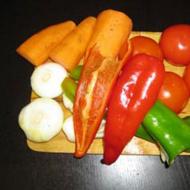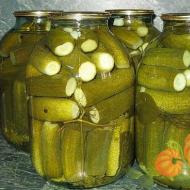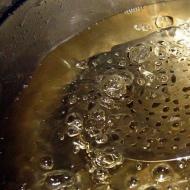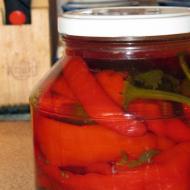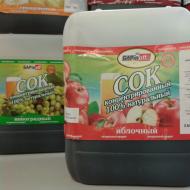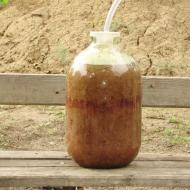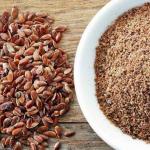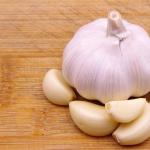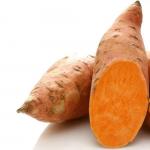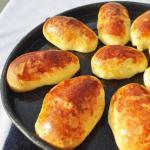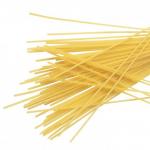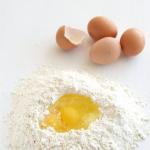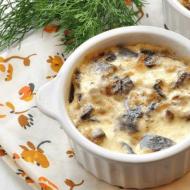
Requirements for the quality of sauces, conditions and terms of their storage. How and how long to store sauces Swelling and gelatinization of starch
Shelf life
Sauce-mayonnaise and its derivatives. prepared in catering establishments. sold within 1-2 days, stored at a temperature of 10-15 0 C in a non-oxidizing container.
Salad dressings are stored in bottles in the refrigerator at a temperature of 5 0 C, sold within 1-2 days.
Green and herring oil shaped into a bar wrapped in foil, parchment or plastic wrap. Store in the refrigerator for 1-2 days.
This is interesting
First, in 1757, Mahon was captured by the French under the leadership of the Duke de Richelieu (a relative of the same Duke and Cardinal Armand Jean du Plessis Richelieu, who lived from 1585 to 1642, who in the Three Musketeers besieged the Huguenot fortress of La Rochelle, which fell in 1628, and in the siege of which he actually took part Royal Musketeer René Descartes). The city was soon besieged by the British. Like his ancestor, Richelieu was going to hold his position even under fear of starvation to the bitter end.
And with food in the besieged city, it was tense - only olive oil and turkey eggs remained. How much can be prepared from such a set?
The garrison cooks, who themselves were tired of such a meager “menu”, during the siege tried to diversify it with all their might, experimented as best they could, but the range of available products was too scarce.
When the French garrison and Richelieu himself could no longer look at all sorts of omelettes and scrambled eggs, the duke's cook, who also showed extraordinary soldier's ingenuity, finally found an excellent solution that glorified him forever, but, unfortunately, did not save his name (he forgot to call the sauce by his name in a heavy siege struggle).
So, this resourceful cook thoroughly ground fresh egg yolks with sugar and salt and gradually, pouring in small portions and each time actively stirring until completely homogeneous, mixed everything with olive oil, then added lemon juice to the mixture and again thoroughly mixed everything. (This is the classic mayonnaise recipe).
Even the simplest soldier's bread with such an additive became amazingly tasty!
Richelieu and his soldiers were delighted. The victory over the enemy was assured! This is how a wonderful sauce appeared, later named after the besieged city - “maon sauce” or “mayonnaise”.
production task
2 Prepare 700g of each type of sauce.
3 Complete and submit your work.
Questions and tasks for independent work
1 Draw up a flow chart for the preparation of prepared sauces.
2 Learn the technology of making cold sauces
Option 1 Vegetable marinade with tomato. No. 827 Sat. rev., 2011.
Option 2. 1 Vegetable marinade with beets №829 Sat. rev., 2011.
Draw up technological maps and cooking schemes for the indicated dishes.
LABORATORY PRACTICAL LESSON №6
PREPARATION OF DISHES FROM BOILED AND SPEALED VEGETABLES
General information
For cooking, vegetables are subjected to various heat treatment methods - boiling, poaching, frying, stewing and baking.
During heat treatment, various physicochemical changes occur in vegetables, as a result of which they acquire new properties characteristic of culinary processed products.
The nutritional value of vegetable dishes is due to the high content of vitamins, carbohydrates and mineral salts, which are easily digestible and necessary for the human body.
Mineral salts, carbohydrates and vitamin C contained in vegetables dissolve easily in water, therefore it is not recommended to leave peeled vegetables for a long time in cold water; this is especially true for peeled and chopped potatoes, the activity of vitamin C in which, when stored in water, is reduced by 40%. For better preservation of vitamin C, vegetables should be dipped in boiling water during cooking and boiled in a sealed container at a low boil.
Careful observance of the technological rules for the culinary processing of vegetables contributes to a more complete preservation of vitamins, mineral salts and other nutrients in the prepared vegetable dishes.
Ready-to-eat vegetable dishes are recommended to be sprinkled with finely chopped parsley, dill (2-3g net per serving) or green onions (5-10g net per serving). Potato dishes can be served additionally with fresh or pickled cucumbers, tomatoes, sauerkraut, salted and pickled mushrooms, canned vegetable snacks (eggplant caviar, squash, stuffed peppers, etc.) in the amount of 50-100g net per serving.
Potatoes and carrots are boiled peeled, beets - in the skin. Dried vegetables are washed before cooking, poured with water and left to swell for 1-3 hours, then boiled in the same water. Dried mushrooms are also prepared and boiled.
Vegetables can be boiled in water or steamed. Potatoes and carrots are best steamed.
When cooking in water, potatoes and vegetables are placed in boiling water (the water level should be 1-1.5 cm higher than the vegetables) and salt is added (10 g per 1 liter of water). Beets and carrots are cooked without salt, as it impairs their taste and slows down the cooking process.
During the cooking of peeled vegetables, various nutrients pass into the broth, so broths should be used for making soups and sauces.
Freshly frozen vegetables, without defrosting, are placed in boiling water.
Canned vegetables are heated together with the broth, and then the broth is drained.
Goal of the work
1 To form students' skills in organizing the workplace, familiarize them with inventory, tools, equipment for cooking dishes from boiled and poached vegetables.
2 Develop skills in preparing and serving dishes from boiled and stewed vegetables, working with regulatory and technical documents, rational use of working time.
3 To teach students safe labor practices when preparing dishes from boiled and poached vegetables, sanitation rules, culling (quality assessment) of dishes.
Equipment: electric desktop scales, electric stove "Dream" model 29, wiping mechanism, industrial tables.
Inventory, tools, utensils: pots with a capacity of 1-1.5 liters, bowls, spoons, gravy boats, cutting boards OS, OV.
Raw material: potatoes, carrots, canned green peas, white cabbage, cauliflower, table margarine, spices.
Sauces with flour should have a smooth consistency, without lumps of flour and the formation of a film on the surface. To prevent the film from forming, the finished sauce is “pinched”, put pieces of butter or margarine.
In sauces without flour, in butter, there should be no flakes from curdled protein. In marinades, vegetables are cut into the correct shape, they should be soft, the taste should be sour-spicy. Color of sauces: red - from red to brown, white - from white to pale cream. Dairy and sour cream sauces have a color corresponding to the main product, with a slightly grayish tint. The taste of red sauces is sweet and sour, white sauces are pronounced staples.
Burnt flour, extraneous odors, excess salt and spices are not allowed.
Mayonnaise sauces should have a uniform consistency, without stratification of fat from the main mass.
Hot sauces are stored on a food warmer at a temperature of 70-80 ° C for up to 4 hours, sour cream - up to 2 hours, milk - 1.5 hours.
Milk sauce of medium density is not subject to storage.
Oil mixtures are cooled and used for their intended purpose.
Marinades are stored with the lid closed in a non-oxidizing container for 48-72 hours.
Control questions and tasks
1. On what basis are sauces classified?
2. For what purpose is flour passivated?
3. Make a flow chart for the preparation of the main red sauce.
4. What dishes are served with red sauces?
5. How are white sauces prepared in fish broth?
6. What products are included in the mushroom sauce?
7. What is the difference between Polish sauce and cracker sauce?
8. What products and in what quantity are included in the mayonnaise sauce?
9. Name the number of products needed to prepare milk sauce of different thicknesses.
DISHES AND SIDE DISHES FROM GRAINS, PULSES AND PASTA
General provisions
Most cereals are easily absorbed by the body, so they are widely used in baby food. Cereals in terms of biological value are arranged as follows: in the first place - buckwheat and oatmeal; in last place - semolina and rice. The usefulness and digestibility of cereals is higher if they are initially boiled in water, and then in milk, or porridge, served separately as a side dish. The energy value of all cereals is almost the same.
Least of all vitamins in semolina. The nutritional value of buckwheat is high. Cereals are an important source of protein. To replenish porridges with essential amino acids, they are combined with milk, cottage cheese, fish, meat, etc. Fat is added to improve the taste and appearance. The duration of cooking cereals is different, it depends on the type, degree of grinding of cereals, pre-treatment.
Bean and corn dishes are highly nutritious and high in protein, on average up to 25 %. The largest amount is found in soy. Dishes from legumes are more difficult to digest than from cereals. They are rich in carbohydrates - up to 45%, vitamins of group B and others, fats - up to 2%, contain the largest amount of potassium, exceeding the content of other minerals by 2-3 times, phosphorus, magnesium and iron.
According to the method of heat treatment, cereals are classified into crumbly, viscous and liquid.
Loose porridges are prepared by poaching and boiling in a large amount of water - a folding method. Porridges increase in volume and weight (Table 8).
Pasta is cooked in two ways: the first method is folding (cooking in a large amount of water, per 1 kg - 5-6 l of water); the second method is priming (per 1 kg - 2.2 liters of water).
Groats preparation. Barley groats are washed in slightly warm
water, "Hercules" And semolina is not washed.
Pearl barley is poured with cold water for 3-4 hours to speed up cooking.
Rice is washed in warm water several times, the first time at 40°C, the second at 50°C, and the third at 60°C.
Wheat groats are sorted, sieved and dried in an oven at a temperature of 100-110°C.
Millet is washed until the water becomes clear, the groats are scalded to remove bitterness.
Kashi
Loose porridge. The porridge should be cooked in a thick bottomed pan. Porridges are boiled in water or broth from all types of cereals. The prepared cereals are poured into salted boiling water, empty grains that have floated to the surface are removed. Initially, the porridge is stirred. Fat is added during cooking, then it is evenly distributed in the porridge. When the porridge thickens, cover it with a lid and bring to readiness on the edge of the stove or in the oven. Porridges are cooked in a bowl with small volumes.
Loose rice porridge can be cooked in a folding way (5-6 liters of water per 1 kg of cereal). Ready rice is discarded and washed with hot boiled water, then seasoned with melted butter or margarine.
On vacation, porridge is placed in a pile on a plate, poured over with fat or sprinkled with sugar. Boiled milk is served in a glass or milk jug. Porridges with fillers are prepared from all cereals, except corn. Porridges are prepared with bacon and onions, with champignons, mushrooms and onions, with carrots, onions and eggs, with mushroom sauce, pumpkin, cottage cheese, etc.
Buckwheat porridge with bacon and onions. Cook crumbly porridge, as indicated earlier. The bacon cut into small cubes is placed in a frying pan for heating, onions are added there, cut into rings or half rings, and fried until golden brown. Porridge is seasoned with lard and onions. Sprinkle with herbs on vacation.
Nanny(porridge dish). Buckwheat is sorted and washed. It is necessary to put salt into boiling milk, pour in cereals (for 1 kg - 3.2 liters of milk), bring to a boil, remove the foam. Stir occasionally, cook until fully cooked (30 minutes). The porridge is cooled to a temperature of 40-50 ° C, raw eggs are added, mixed. Fill pre-treated pig intestines, the ends of which are tied. Fry in a pan with lard until golden brown. On vacation, they are laid on a warmed dish, poured over with fat formed during frying, decorated with greens. Served with sauerkraut soup or as an independent dish. Vacation temperature 65°C.
Homemade sauces, without the addition of preservatives, as a rule, either cannot be stored at all, or have a limited shelf life.
This is why the preparation for sauces for most is that the sauce is selected in the store or mixed from ready-made ingredients (tartar, in fact, can be obtained simply by mixing ketchup with mayonnaise).
Storing homemade sauces
If you need to keep the taste of hot sauce for a short time (for example, you prepared the sauce in advance, and guests will come to you only in the evening), then before serving, hot sauce is stored in a water bath (water bath - marlite) in a container with a lid.
The temperature of the bath water depends on the type of sauce and ranges from 40 to 80°C.
- Hot sauces on mushroom, fish, meat broths should not be stored longer than 4 hours and should not exceed the storage temperature, which is 85 ° C
- Egg-butter sauces do have a storage limit of 1.5 hours at a temperature not exceeding 65 ° C, otherwise they can delaminate into fractions.
- Any liquid sauce, other than those listed, should not be stored for more than 1.5 hours at a temperature of 65 ° C.
A little trick. To avoid the appearance of a "film" on the surface of the sauce, you can put a piece of butter under the lid, if appropriate. No - then just stir your sauce occasionally and strain before serving.
Long term storage of sauces
Are you unable to meet the deadlines above? No problem. Remember the main rule - sauce heated to the right temperature has better taste than sauce with an overexposed shelf life.
So if you know for sure that guests or a banquet are delayed, feel free to cool the sauce to room temperature and put it in the refrigerator.
To prolong the storage of sauces, always use clean, dry dishes. Metal lids should be replaced with natural materials, for example, closing sauce containers with paper.
Instead of plastic dishes for homemade sauces, you should take glass.
If desired, to further increase the period during which the storage of sauces is acceptable, use natural preservatives (lemon, pepper, salt, mustard). For example, ordinary homemade mayonnaise is stored for 2-3 days, but if you add mustard to it, then the shelf life increases to 6-7 days.
Steam sauce. The main white sauce is seasoned with citric acid, boiled and boiled white wine is added. Served with stewed meat dishes, chickens, chickens, veal, etc. You can add a decoction of champignons to it.
White sauce with egg. Egg yolks are rubbed with margarine or butter, cream or broth is added and heated in a water bath (75-80 ° C), stirring continuously. This mixture, with stirring, is added to a hot white sauce (75-80 ° C), seasoned with grated nutmeg, citric acid, and salt. Served with dishes of stewed and boiled veal, chickens, chickens, lamb.
White sauce with vegetables. Carrots, parsley or celery and onions are cut into small cubes and sautéed for 3-5 minutes, a little broth is added and, having covered the dishes with a lid, simmer until tender. Finely chopped turnips and bean pods are boiled separately. Ready vegetables are added to the white sauce, boiled, seasoned with salt, citric acid and oil. Served with dishes of boiled lamb, rabbit, poultry, steam meat cutlets.
7. Requirements for the quality and storage of sauces
The liquid part of sauces with flour should be homogeneous, without lumps; the oil does not flake off. Side dishes introduced into the sauce should be soft, brought to readiness. The taste and aroma of sauces are well expressed.
Hot sauces with flour are stored on a food warmer in a sealed container for no more than 3 hours. For distribution, sauces are served in small batches for sale within 1-1.5 hours. Ready-made cold sauces are served for distribution in quantities that can be sold in 1-2 hours. It should be borne in mind that Dutch sauces are very unstable, so they should be stored in a water bath at a temperature not exceeding 80 "C.
In restaurants, ceramic and metal gravy boats of various capacities are used to serve sauces.
When culling, first determine the consistency of the sauce, pouring it in a thin stream and tasting it. Most sauces should have the consistency of liquid sour cream when hot.
Then they determine the color, taste and aroma, the consistency of the fillers, the shape of the side dishes and the composition (onions, cucumbers, root crops, etc.). Decisive in the assessment of sauces are taste and aroma. .
Inadmissible defects in sauces: extraneous unpleasant odors and tastes; the smell of raw flour and stickiness (the flour was not passivated); the smell and taste of burnt flour; watery taste and faint smell of meat, fish and poultry (weak broth); salting; smell and taste of raw tomato (badly sautéed tomato); the presence of lumps of brewed flour (flour passivation was brewed with very hot water and not filtered); separation of oil in sauces with egg-butter lezon; the presence of dark grains and a bitter aftertaste (burnt vegetables); poorly peeled vegetables.
Red meat sauces should have a rich meat taste, close to the taste of juice from roasting meat, with a sweet and sour taste, color from brown to brown-red, aroma of sautéed vegetables and spices. The smell of bay leaf should not prevail in the "bouquet".
In sauces with wine, the aroma of wine should be well expressed. Vinegar in sauces should not be felt. In onion sauces, the onion should be finely chopped. These sauces have a strong aroma of sautéed onions and spices. The roots in sauces with fillers should be soft. Overcooked or very dense vegetables are unacceptable.
A defect in mustard sauce is curdled grains of mustard. Fillers (vegetables, onions, capers, gherkins, etc.) should be evenly distributed throughout the mass. Meat white, tomato and sour cream sauces should have the taste of meat white sauces (in meat or chicken broth), with the aroma of sautéed white roots and onions. Steam sauce should have a pleasant sour taste. The consistency is elastic, like cream, without lumps and grains. The color is white or cream. The aroma is delicate, without the smell of bay leaf. The absence of citric acid in the steam sauce, white with egg is considered a defect.
The main defects of sour cream sauces are the use of low-quality sour cream - with high acidity, extraneous flavors or lack of sour cream. In addition, there may be defects depending on the flour passivation - a burnt taste, lumpiness. If the sauce is not boiled well, then the smell of raw sour cream is felt.
Fish sauces should have a characteristic, strongly pronounced taste and aroma of white roots, fish, spices. The main defect is the insufficient concentration of the broth. Fish sauces are bitter if the gills were not removed from the heads of the fish when the broth was boiled, or if the food waste was not washed well. Filler defects are: the presence of pitted olives, poor peeling of root crops, violation of the cut shape, the presence of unpeeled or overripe cucumbers. An incomplete set of fillers is evaluated as a marriage. A particularly frequent violation is the absence of white roots.
7.1 Processes involved in the preparation of the sauce
When preparing a white base sauce, the flour is sautéed with fat. Flour is added to sauces to give a certain consistency. Raw flour gives sauces an unpleasant stickiness and taste. Therefore, the flour is passivated, i.e. dried without color change at 120C or with color change to light brown at 150C. A higher temperature is not used, as the flour acquires an unpleasant aftertaste of "burnt".
When passing through flour, partial (at 120C) or almost complete (at 150C) denaturation of proteins occurs. They lose their ability to swell and, when combined with broth (water), do not form gluten.
The appearance of colored products and a specific smell is explained by the reaction of melanoidin formation.
Starch has a significant effect on the consistency of the sauce. During passaging, its dextrinization occurs, while starch grains are partially destroyed and lose their ability to gelatinize. Therefore, the sauces are elastic, non-sticky, with a pleasant aroma.
All processes associated with swelling and gelatinization of starch during further boiling of flour with liquid end after about 20 minutes, so sauces should not be boiled for a long time.
Passage flour can be with or without fat. To obtain fat passivation, the sifted flour is poured into melted fat and heated, stirring continuously. Fat ensures uniform heating of the flour and, upon subsequent dilution with broth, prevents the formation of lumps. Fat passivation is usually diluted with hot broth.
Dry, or fat-free, passivation is prepared by heating the sifted flour with a layer of more than 5 cm. To prepare a large amount of dry passivation, the flour is mixed with salt (up to 20% of the flour mass) and heated while stirring. Salt prevents the formation of lumps when breeding passivation with broth. Dry passivation is diluted with a small amount of broth cooled to 50 ° C in order to avoid premature gelatinization of starch and the formation of lumps.
Depending on the color, red and white passivation is distinguished.
7.1.1 Swelling and gelatinization of starch
Swelling is one of the most important properties of starch, which affects the consistency and shape, volume and yield of finished products.
Traditionally, not only drinks are placed on the door shelf of the refrigerator, but also various sauces, as well as home-made preparations, without which we simply cannot imagine our favorite dishes. Unfortunately, after opening the package or uncorking the jar, their shelf life is significantly reduced. So that the products do not disappear, use our cheat sheet.
Why do open sauces and homemade preparations have a short shelf life?
The fact is that after opening the package, the products come into contact with the surrounding air. Under the influence of microorganisms, as well as the processes of oxidation and weathering, they deteriorate much faster, losing their original taste and aroma. Therefore, from time to time, they need to be checked and get rid of what can no longer be applied. So you not only protect yourself from the danger of eating stale food, but also protect the rest of the food in the refrigerator: over time, mold will form on stale sauces, the spores of which can spread to food stored nearby.
Of course, you can always see the expiration date of the product, but in most cases it is relevant only if the packaging is intact. In this regard, we have prepared a small list of the most common sauces and preparations with an indication of the approximate time of their storage in the refrigerator.
Note: Please note that these times are indicative. They are relevant only for products purchased in the store, and may differ depending on storage conditions.
Sauces

- ketchup- 6 months
- salad dressing- 6 months with tightly closed lid
- barbecue sauce- 4 months
- hot sauce (chili)- 5 years
- salsa- 5-7 days
- soy sauce- 2 years
- tartar sauce- 6 months
- mayonnaise- 2-3 months depending on expiration date
- mustard- 1 year
- horseradish- 3-4 months
Pickles

- capers- 1 year in a brine jar
- olives- 2-3 months in a jar of brine
- the rest of the pickles- 1 year with tightly closed lid
Jam
 Jam and jam- 1 year with tightly closed lid.
Jam and jam- 1 year with tightly closed lid.
Now you will always have a cheat sheet at hand, showing you when to give up certain foods that have been stored on the door shelf of your refrigerator for a long time. If some of them are about to expire, use them as soon as possible in your favorite dishes.
If you have questions or comments, please write to us. Use the comment form below or join the community discussion

